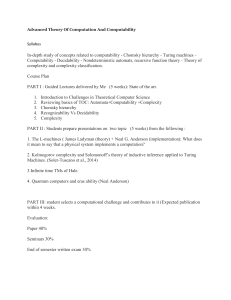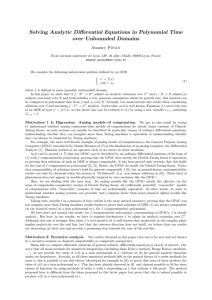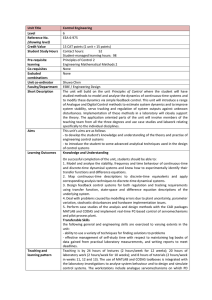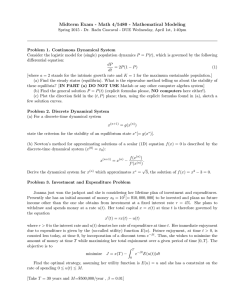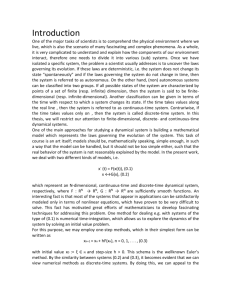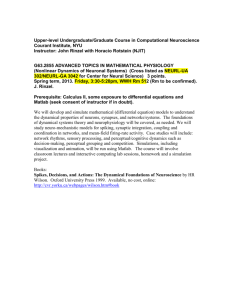Computability with continuous-time dynamical systems Daniel S. Gra¸ca January 12, 2009 1
advertisement
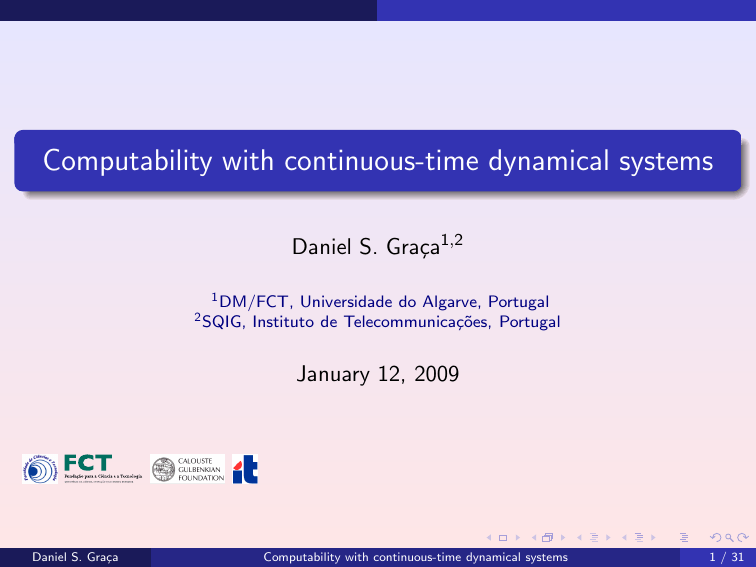
Computability with continuous-time dynamical systems Daniel S. Graça1,2 1 DM/FCT, 2 SQIG, Universidade do Algarve, Portugal Instituto de Telecommunicações, Portugal January 12, 2009 Daniel S. Graça Computability with continuous-time dynamical systems 1 / 31 Introduction Outline 1 Introduction Motivation 2 The GPAC The differential analyzer Shannon’s work The extended analog computer 3 The PGPAC Presentation Main results 4 Conclusions/perspectives Selected references Daniel S. Graça Computability with continuous-time dynamical systems 2 / 31 Introduction Motivation Motivation There is a longstanding tradition of considering both discrete and continuous models for natural phenomena Leucippus and Democritus (ca. 400 BC) advocated that matter is not infinitely divisible and is constituted by particles, the atoms. In classical physics, time and space are idealized as continuous According to the work of Planck (ca. 1900), there is a minimum amount of time and space that can be measured. While it is unclear whether real numbers have a physical meaning, they are mathematically useful for a large number of domains. Daniel S. Graça Computability with continuous-time dynamical systems 3 / 31 Introduction Motivation The digital paradigm Church-Turing Thesis: Every function computable according to the intuitive notion of algorithm is computable by a Turing machine Not to confound with the following stronger claim: Whatever can be calculated by a reasonable physical device is Turing computable. So, what is the situation for analog computers? Daniel S. Graça Computability with continuous-time dynamical systems 4 / 31 Introduction Motivation Characteristics of analog computation Usually agreed views in analog computation [Siegelmann] Any physical system or dynamical behavior in nature can be perceived as performing a computational process These processes can be modeled by dynamical systems, associated to some state space An analog computer should use a continuous state space However, there is no widely accepted Universal Analog Computer, i.e., there is no counterpart of the Church-Turing Thesis for analog computation Daniel S. Graça Computability with continuous-time dynamical systems 5 / 31 Introduction Motivation Importance of analog computation Many engineering problems are stated using real data/continuous dynamical systems. Digital computers truncate data, while analog computers do not. Can this be used as a future complement/alternative to digital microprocessors, where an analog “co-processor” would solve more efficiently certain classes of problems? (work of Jonathan Mills at University of Indiana) Can we relate problems over continuous dynamical systems with standard computability? (useful for control theory, etc.) Is there a Church-Turing Thesis for analog computation, or do we have to stick to a plethora of different models? Daniel S. Graça Computability with continuous-time dynamical systems 6 / 31 Introduction Motivation Motivations for our research Many models of analog computation found in the literature are based on characteristics borrowed from digital computers (e.g. treat real numbers as sequences of bits. Use dynamics that are not smooth), and may not be adequate for some applications Considering that classical models in Physics usually depend on analytic dynamics, it would be interesting to have an analog model of computation suited to this case By this reason, we focused our research on an older model of analog computation. With this we hope to gain some insight in the possibilities offered by analog computation Daniel S. Graça Computability with continuous-time dynamical systems 7 / 31 The GPAC The differential analyzer The differential analyzer The principles underlying this computing device were first described by Lord Kelvin in 1876 A fully operational Differential Analyzer was assembled at MIT in 1931, under the supervision of V. Bush Several mechanical Differential Analyzers were built in the 1930s and 1940s, especially during the U.S. war effort. Their applications ranged from gunfire control up to aircraft design In the late forties, they were substituted by electronic versions that remained in use up to the beginnings of the 1970s Daniel S. Graça Computability with continuous-time dynamical systems 8 / 31 The GPAC The differential analyzer A mechanical integrator: Bureau of Naval Personnel, Basic Machines and How They Work, 1964 Daniel S. Graça Computability with continuous-time dynamical systems 9 / 31 The GPAC Shannon’s work The GPAC In 1941, Claude Shannon presented a paper entitled “Mathematical theory of the Differential Analyzer”, where he first described the General Purpose Analog Computer (GPAC). k u v k A constant unit associated to the real value k u v i a+ itt u(x)dv(x) 0 An integrator unit Daniel S. Graça + u+v An adder unit u v x uv A multiplier unit Computability with continuous-time dynamical systems 10 / 31 The GPAC Shannon’s work Example Example Compute y (x) = e x with a GPAC t i et y′ = y y (0) = 1 Daniel S. Graça Computability with continuous-time dynamical systems 11 / 31 The GPAC Shannon’s work Main features of the GPAC Real numbers are not treated as strings of digits Assumes continuous-time dynamics The computation is performed in real time: for a GPAC computing a function f , if an input x is given at time t, the output at time t is f (x), i.e. the computation took 0 time units to be carried out. Generates analytic functions (i.e. it has smooth dynamics) Daniel S. Graça Computability with continuous-time dynamical systems 12 / 31 The GPAC Shannon’s work Shannon’s algebraic-differential characterization Definition The unary function y : R → R is differentially algebraic (d.a.) on I ⊆ R if there is a nonzero polynomial p with real coefficients such that on I . (1) p x, y , y ′ , ..., y (n) = 0, Theorem (Shannon) A unary function y is generated by a GPAC on an interval I ⊆ R iff it is d.a. on I . Daniel S. Graça Computability with continuous-time dynamical systems 13 / 31 The GPAC Shannon’s work This result implies that: 1 The GPAC computes polynomials, the exponential function, the usual trigonometric functions, their inverses as well as the finite composition and quotients of all these functions wherever they are well defined; 2 The Gamma function Γ(x) = Z ∞ t x−1 e −t dt 0 and Riemann’s zeta function ζ(x) = ∞ X 1 nx n=1 cannot be computed by a GPAC. Daniel S. Graça Computability with continuous-time dynamical systems 14 / 31 The GPAC Shannon’s work Problems of Shannon’s GPAC Shannon’s assumes that his circuits have an output and that this output is unique. However, he does not provide any criteria to know when this happens (in particular, is this problem decidable?) The result relating the GPAC with d.a. functions has a gap (first noticed by Pour-El in 1974) Daniel S. Graça Computability with continuous-time dynamical systems 15 / 31 The GPAC Shannon’s work + 1 Figure 1: A circuit that admits no solutions as outputs. 1 t + i + y Figure 2: A circuit that admits two distinct solutions as outputs. Daniel S. Graça Computability with continuous-time dynamical systems 16 / 31 The GPAC Shannon’s work Other work In 1974, M. B. Pour-El pointed out a gap on Shannon’s proof. She also redefined the GPAC in order to prove Theorem 1. Nevertheless, it is not clear if her model, based on system of differential equations, has anything to do with the Differential Analyzer. Further refinements where made by Lipshitz and Rubel (1987). Daniel S. Graça Computability with continuous-time dynamical systems 17 / 31 The GPAC The extended analog computer The Extended Analog Computer In 1993, L.A. Rubel presented an extension of the GPAC, the Extended Analog Computer (EAC). This model has the following features: 1 It has all the units of the GPAC, plus units that can compute Partial Differential Equations (PDEs), inverse functions, and limits (this later, with some restrictions); 2 It can compute functions that are not computable by the GPAC (e.g. Γ, ζ) and solve problems not solvable by a GPAC (namely problems involving PDEs and limits); 3 Contrarily to the GPAC, it is not based on any physical device, and its realizability remains unknown (remark: recently, researchers from the Indiana University were able to produce analog VLSI units capable of computing PDEs) Daniel S. Graça Computability with continuous-time dynamical systems 18 / 31 The PGPAC Presentation Our approach Use Shannon’s model, but with restrictions on the layout of the circuits 1 Polynomial circuits: acyclic circuits built in layers, without using integrators. Lemma Polynomial circuits generate exactly the class of polynomial functions 2 Use polynomial circuit as building blocks to obtain polynomial GPACs. Daniel S. Graça Computability with continuous-time dynamical systems 19 / 31 The PGPAC Presentation The basic block of the PGPAC ... t y1 yn Ak p(t, y1 ,...,yn ) t i yk Here t is the input and yk is the output of the kth integrator. Ak is a polynomial circuit. Daniel S. Graça Computability with continuous-time dynamical systems 20 / 31 The PGPAC Main results Main results I (Graça, Costa) Theorem (Shannon =⇒ part) If a unary function y is generated by a PGPAC in I ⊆ R then it is d.a. on I . Theorem (Shannon ⇐= part) If a unary function y is d.a. in I ⊆ R then it is generated by a PGPAC in some I ′ ⊆ I , where I ′ has non-empty interior. Corollary (connection with dynamical systems) y is generated by a PGPAC iff it is a solution of y′ = p(y, x), where p is a vector of polynomials. Daniel S. Graça Computability with continuous-time dynamical systems 21 / 31 The PGPAC Main results In particular, the last result guarantees that the PGPAC is well behaved. Because our model is well behaved, is based on circuits (Shannon’s approach), can be written as a system of differential equations (Pour-El’s approach), and has the main properties stated by Shannon and Pour-El, solving previous problems, we decided to call it “the GPAC”. However, we drop the initial motivation based in circuits. Instead we stress on the fact that the GPAC generate solutions of polynomial systems of the form y′ = p(y, x). We call solutions of these systems PIVP functions. We think this a more elegant and useful characterization of the GPAC. Daniel S. Graça Computability with continuous-time dynamical systems 22 / 31 The PGPAC Main results Properties of PIVP functions The PIVP functions are closed under the following operations (as far as we know, these properties have only been reported in the literature for the broader case of differentially algebraic functions): Field operations +, −, ×, / Composition Differentiation Compositional inverses Corollary All closed-form functions (i.e. elementary functions in Analysis which, informally, correspond to the functions obtained from the rational functions, sin, cos, exp through finitely many compositions and inversions) are PIVP functions. Daniel S. Graça Computability with continuous-time dynamical systems 23 / 31 The PGPAC Main results Main results II (Graça, Campagnolo, Buescu) Theorem (robust continuous-time simulation of TM’s) Let θ : N3 → N3 be the encoding of the transition function of a Turing machine M and let 0 < δ < ε < 1/2. Then there is a PIVP function gM : R6 → R6 such that the ODE z ′ = gM (z, t) robustly simulates M in the following sense: there is some 0 < η < 1/2 such that for all g satisfying kg − gM k∞ < 1/2, and for all x̄0 ∈ R3 satisfying kx̄0 − x0 k∞ ≤ ε, where x0 ∈ N3 represents an initial configuration, the solution z of z ′ = g (z, t), z(0) = (x̄0 , x̄0 ) has the following property: for all j ∈ N and for all t ∈ [j, j + 1/2], z2 (t) − θ [j] (x0 ) ≤ η. ∞ Daniel S. Graça Computability with continuous-time dynamical systems 24 / 31 The PGPAC Main results Computing Γ with a GPAC Problem: Γ is computable according to Computable Analysis, but not computable by the GPAC. Solution: Change the notion of computability associated to a GPAC. The idea: Apply a limit procedure, similarly to the Computable Analysis case. Input (x0 ) Time (t) GPAC g (x0 , t) g (x0 , t) ε(x0 , t) f (x0 ) t Daniel S. Graça Computability with continuous-time dynamical systems 25 / 31 The PGPAC Main results This can be achieved as follows: 1 use initial settings on integrators to represent the initial input x ∈ Rn 2 use the usual input as a time variable t 3 then f : Rn → R is GPAC*-computable if there is a GPAC with two outputs g (x, t) and ε(x, t) satisfying: 1 2 limt→∞ kε(x, t)k = 0; kg (x, t) − f (x)k ≤ ε(x, t) Theorem Both Γ and ζ are GPAC*-computable Daniel S. Graça Computability with continuous-time dynamical systems 26 / 31 The PGPAC Main results Computable analysis: Type-2 machines Coding a real number x For a sequence (yn , zn )n∈N , where yi , zi ∈ N, we write (yn , zn ) ∀i , |x − (−1)yi 2zii | ≤ 21i x iff M behaves like a Turing Machine An input x is coded on a read-only one-way input tape and the output f (x) is coded on a write-only one-way output tape. If there is a Type-2 machine with these properties, we say that f : R → R is computable. Daniel S. Graça Computability with continuous-time dynamical systems 27 / 31 The PGPAC Main results Main results III (Bournez, Campagnolo, Graça, Hainry) Theorem Let f : [a, b] → R be a real function. Then f is computable (Computable Analysis sense) iff it is GPAC-computable. Daniel S. Graça Computability with continuous-time dynamical systems 28 / 31 Conclusions/perspectives Conclusions/perspectives We have presented a model that relates in a very natural way to a large class of dynamical systems This model robustly simulates Turing machines (achieves Type-1 computability) It is equivalent to computable analysis on compact intervals What happens for unbounded domains? Is this a suitable candidate as a reference model for an analog “Church-Turing” thesis? Daniel S. Graça Computability with continuous-time dynamical systems 29 / 31 Conclusions/perspectives Selected references Selected references [Sha41] C. E. Shannon. Mathematical theory of the differential analyzer. J. Math. Phys. MIT, 20:337–354, 1941. [Pou74] M. B. Pour-El. Abstract computability and its relations to the general purpose analog computer. Trans. Amer. Math. Soc., 199:1–28, 1974 [GC03] D. S. Graça and J. F. Costa. Analog computers and recursive functions over the reals. J. Complexity, 19(5):644–664, 2003 [DCGH07] O. Bournez, M. L. Campagnolo, D. S. Graça, and E. Hainry. Polynomial differential equations compute all real computable functions on computable compact intervals. J. Complexity, 23(3):317–335, 2007 [GCB08] D. S. Graça, M. L. Campagnolo, and J. Buescu. Computability with polynomial differential equations. Adv. Appl. Math., 40(3):330–349, 2008 Daniel S. Graça Computability with continuous-time dynamical systems 30 / 31 Conclusions/perspectives Selected references Thank you! Daniel S. Graça Computability with continuous-time dynamical systems 31 / 31
